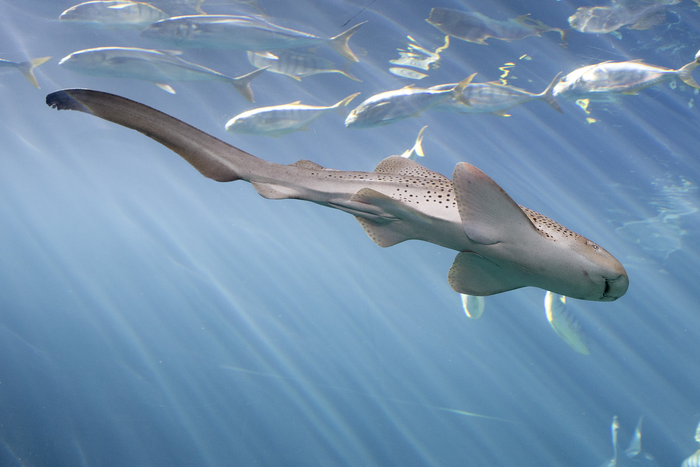Asexual reproduction is common for animals like starfish, deep-sea worms, and stick insects, but among vertebrates, it’s a rarity. A process called parthenogenesis allows some female animals to fertilize an egg with their own genetic material, producing offspring by “virgin birth.” Scientists have assumed that vertebrates that usually reproduce sexually turn to parthenogenesis as a “hail Mary pass,” a last-ditch effort at reproduction when there aren’t enough mates to go around. However, a recent study revealed an example of a female zebra shark in an aquarium reproducing via parthenogenesis, even though there were healthy, reproductive males in the same enclosure.This finding has implications for not only the continued care of zebra sharks in zoos and aquariums, but also for conservation efforts focused on their wild counterparts.

Credit: ©Shedd Aquarium/Brenna Hernandez
Asexual reproduction is common for animals like starfish, deep-sea worms, and stick insects, but among vertebrates, it’s a rarity. A process called parthenogenesis allows some female animals to fertilize an egg with their own genetic material, producing offspring by “virgin birth.” Scientists have assumed that vertebrates that usually reproduce sexually turn to parthenogenesis as a “hail Mary pass,” a last-ditch effort at reproduction when there aren’t enough mates to go around. However, a recent study revealed an example of a female zebra shark in an aquarium reproducing via parthenogenesis, even though there were healthy, reproductive males in the same enclosure.This finding has implications for not only the continued care of zebra sharks in zoos and aquariums, but also for conservation efforts focused on their wild counterparts.
“We’ve known for several years that parthenogenesis occurs in animals like sharks, but some aspects of it remain unknown, like why it occurs and what triggers it,” says Kevin Feldheim, a researcher at Chicago’s Field Museum and the study’s corresponding author. “This latest paper is just another step in learning why these ‘virgin births’ happen.”
The study, published in the Journal of Fish Biology, focuses on endangered zebra sharks at Shedd Aquarium in Chicago.
“As we started to see successful breeding of zebra sharks at Shedd in 2004, we also began genetic testing to confirm which of the sharks were the parents of the offspring,” says Lise Watson, assistant director of animal operations and habitats at Shedd Aquarium and an author of the study. “By confirming the lineage of the offspring, we could more soundly make decisions on future breeding efforts to maintain maximum genetic diversity while supporting the Association of Zoos and Aquarium’s Species Survival Plan for zebra sharks.”
Shedd’s Wild Reef exhibition includes a massive floor-to-ceiling habitat containing a variety of sharks, including zebra sharks. In 2008, Watson and her colleagues noticed a clutch of eggs; they moved them to a nursery behind the scenes to safely hatch. When the shark pups hatched, Jean Dubach of Loyola University analyzed the sharks’ DNA to determine their parentage. The results seemed impossible.
“These pups didn’t match any of the mature males that were in the enclosure. But they did match the female that laid the eggs,” says Feldheim.
In addition to having genetic markers in common with their mother but none of the potential fathers, the pups had identical homozygous copies of some alleles. Think back to the genetics unit in your high school biology class. You probably made Punnett square grids with different gene types represented by upper and lowercase letters, like B as the dominant allele for brown eyes and b as the recessive allele for blue eyes. You get one allele from each parent, and if they’re the same (BB or bb), that’s called homozygous.
The genetic markers used in these sharks are more complicated than just B versus b–they have many more alleles, to the point that it’s virtually impossible that they’d show up exactly the same way in two different individuals. So when the shark pups DNA results came back homozygous, that meant that they had to be getting both of those DNA strands from their mother, rather than from two different parents.
“Discovering these pups were parthenotes was quite a surprise for the team at Shedd, given our previous success in encouraging breeding through sexual reproduction,” says Watson.” This news underscored exactly why regular, ongoing genetic testing of offspring is important.”
Pups born by this type of “virgin birth” unfortunately tend to have a short life expectancy, as they’re likelier to have rare recessive genetic conditions. The shark pups in this study only survived a few months. But the fact that they were born at all challenges long-standing ideas in biology.
“This is only the second case that we know of where sharks have been born by parthenogenesis even when there were healthy mates available,” says Feldheim; the other instance was at the Aquarium of Pacific. “This discovery throws a wrench in what we thought we knew about how and why parthenogenesis happens, and it illustrates a key aspect of science: we’re continually learning.”
“This study is just the beginning of our understanding of the occurrence of this genetic phenomenon in zebra sharks,” says Watson. “Zoos and aquariums like Shedd have a key role to play in the conservation of species like zebra sharks, which are nearly extinct in some parts of the world. Knowing more about parthenogenesis and confirming the genetic makeup of our populations in zoos and aquaria is crucial to making informed decisions that fuel this work..”
###
Journal
Journal of Fish Biology
DOI
10.1111/jfb.15268
Article Title
Parthenogenesis in an elasmobranch in the presence of conspecific males
Article Publication Date
12-Nov-2022



